IKEA 3 Positioning and Differentiation
VerifiedAdded on 2021/09/17
|14
|2556
|322
AI Summary
Assessment of IKEA’s strategy 5 2.1 Value chain 5 2.2 Analysis of the three sources of value (economic, social, and environmental) in IKEA’s value chain 7 2.2.1 Economic 7 2.2.2 Social Value 7 2.2.3 Environmental Value of IKEA 7 2.3 Relation of the value sources to the wants and needs of the core customers of IKEA 8 2.4 Role of IKEA’s supply chain in Value Proposition 8 2.5 Reflection of customer value (economic, social, and environmental) in the
Contribute Materials
Your contribution can guide someone’s learning journey. Share your
documents today.
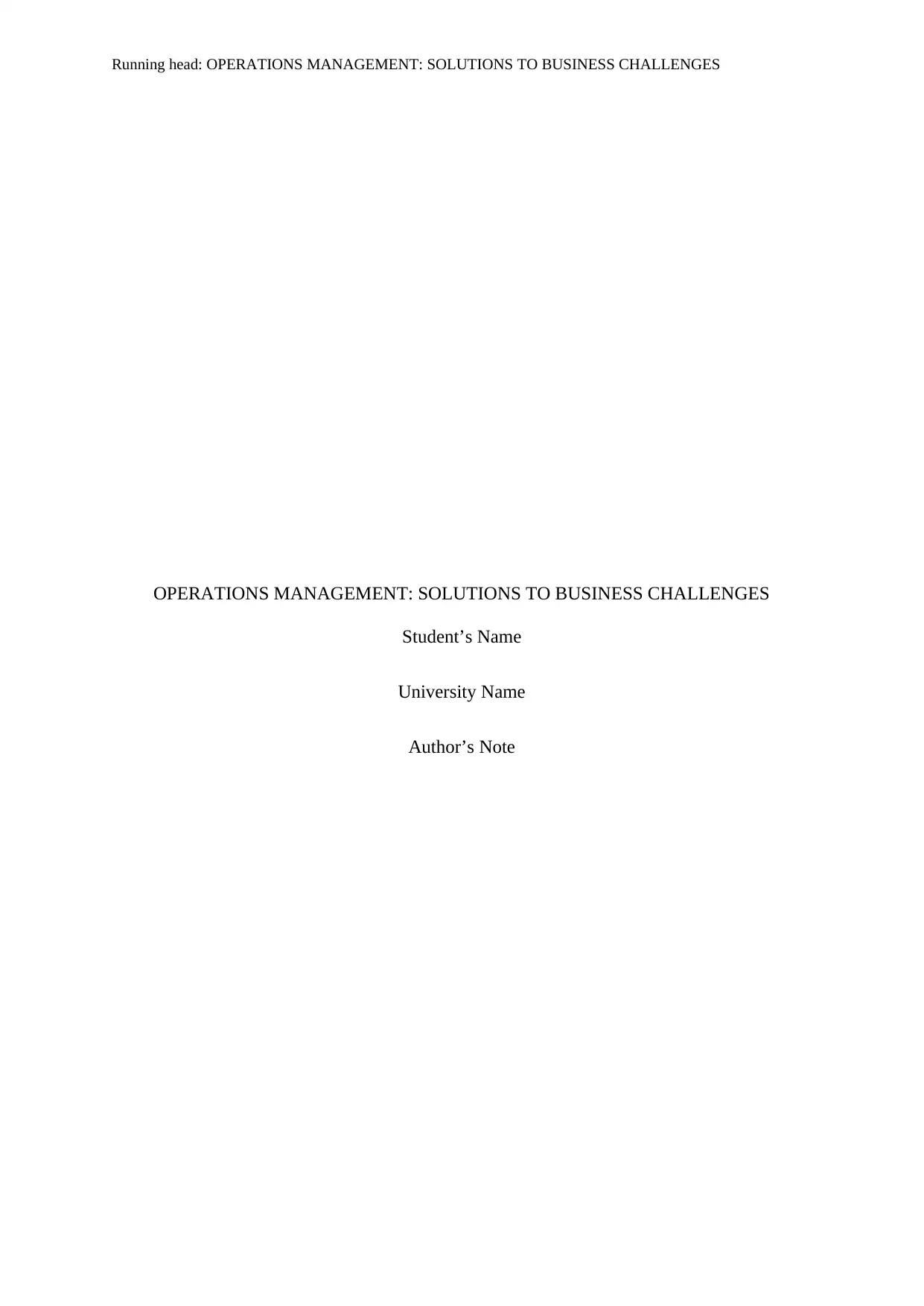
Running head: OPERATIONS MANAGEMENT: SOLUTIONS TO BUSINESS CHALLENGES
OPERATIONS MANAGEMENT: SOLUTIONS TO BUSINESS CHALLENGES
Student’s Name
University Name
Author’s Note
OPERATIONS MANAGEMENT: SOLUTIONS TO BUSINESS CHALLENGES
Student’s Name
University Name
Author’s Note
Secure Best Marks with AI Grader
Need help grading? Try our AI Grader for instant feedback on your assignments.
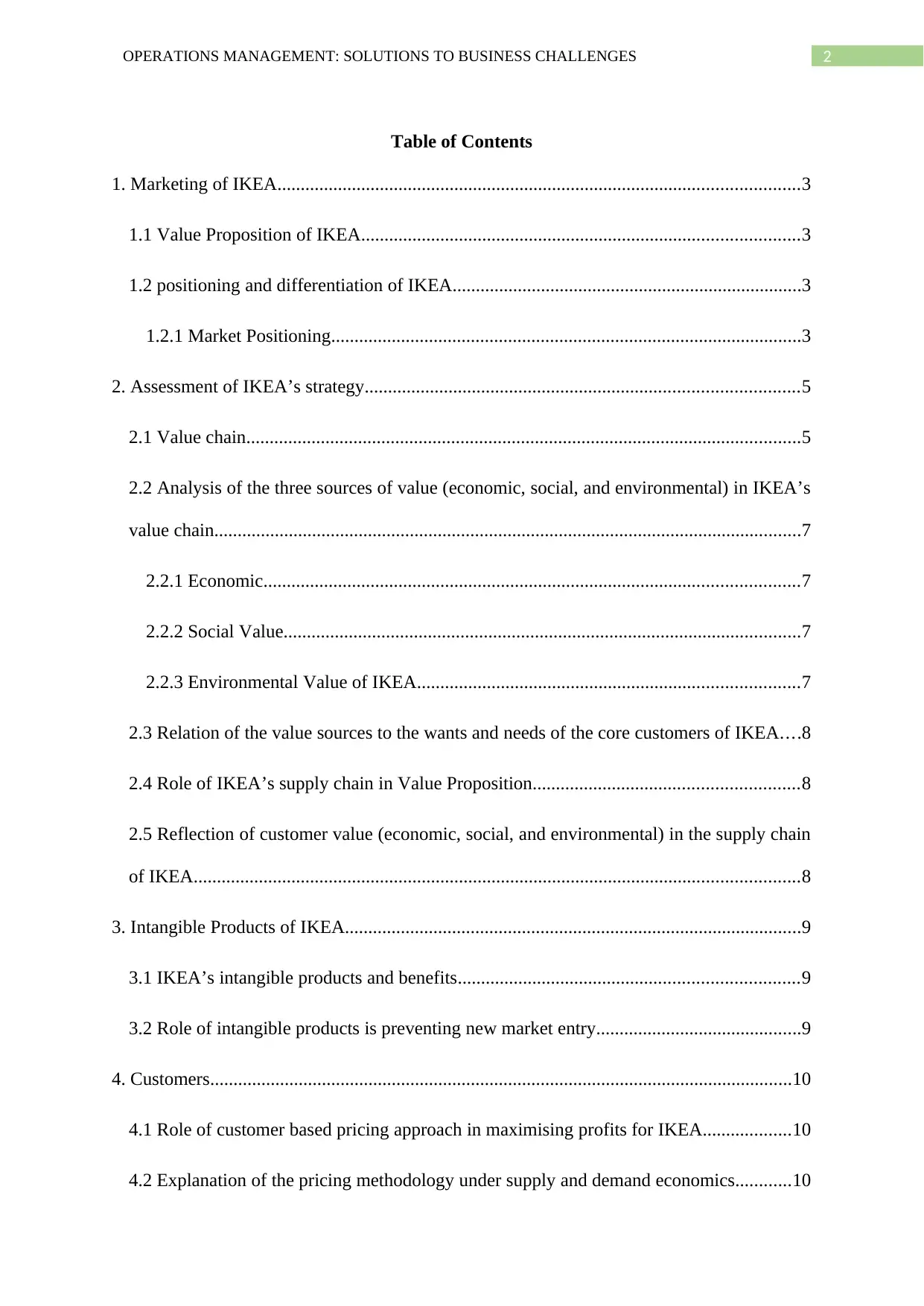
2OPERATIONS MANAGEMENT: SOLUTIONS TO BUSINESS CHALLENGES
Table of Contents
1. Marketing of IKEA................................................................................................................3
1.1 Value Proposition of IKEA..............................................................................................3
1.2 positioning and differentiation of IKEA...........................................................................3
1.2.1 Market Positioning.....................................................................................................3
2. Assessment of IKEA’s strategy.............................................................................................5
2.1 Value chain.......................................................................................................................5
2.2 Analysis of the three sources of value (economic, social, and environmental) in IKEA’s
value chain..............................................................................................................................7
2.2.1 Economic...................................................................................................................7
2.2.2 Social Value...............................................................................................................7
2.2.3 Environmental Value of IKEA..................................................................................7
2.3 Relation of the value sources to the wants and needs of the core customers of IKEA....8
2.4 Role of IKEA’s supply chain in Value Proposition.........................................................8
2.5 Reflection of customer value (economic, social, and environmental) in the supply chain
of IKEA..................................................................................................................................8
3. Intangible Products of IKEA..................................................................................................9
3.1 IKEA’s intangible products and benefits.........................................................................9
3.2 Role of intangible products is preventing new market entry............................................9
4. Customers.............................................................................................................................10
4.1 Role of customer based pricing approach in maximising profits for IKEA...................10
4.2 Explanation of the pricing methodology under supply and demand economics............10
Table of Contents
1. Marketing of IKEA................................................................................................................3
1.1 Value Proposition of IKEA..............................................................................................3
1.2 positioning and differentiation of IKEA...........................................................................3
1.2.1 Market Positioning.....................................................................................................3
2. Assessment of IKEA’s strategy.............................................................................................5
2.1 Value chain.......................................................................................................................5
2.2 Analysis of the three sources of value (economic, social, and environmental) in IKEA’s
value chain..............................................................................................................................7
2.2.1 Economic...................................................................................................................7
2.2.2 Social Value...............................................................................................................7
2.2.3 Environmental Value of IKEA..................................................................................7
2.3 Relation of the value sources to the wants and needs of the core customers of IKEA....8
2.4 Role of IKEA’s supply chain in Value Proposition.........................................................8
2.5 Reflection of customer value (economic, social, and environmental) in the supply chain
of IKEA..................................................................................................................................8
3. Intangible Products of IKEA..................................................................................................9
3.1 IKEA’s intangible products and benefits.........................................................................9
3.2 Role of intangible products is preventing new market entry............................................9
4. Customers.............................................................................................................................10
4.1 Role of customer based pricing approach in maximising profits for IKEA...................10
4.2 Explanation of the pricing methodology under supply and demand economics............10
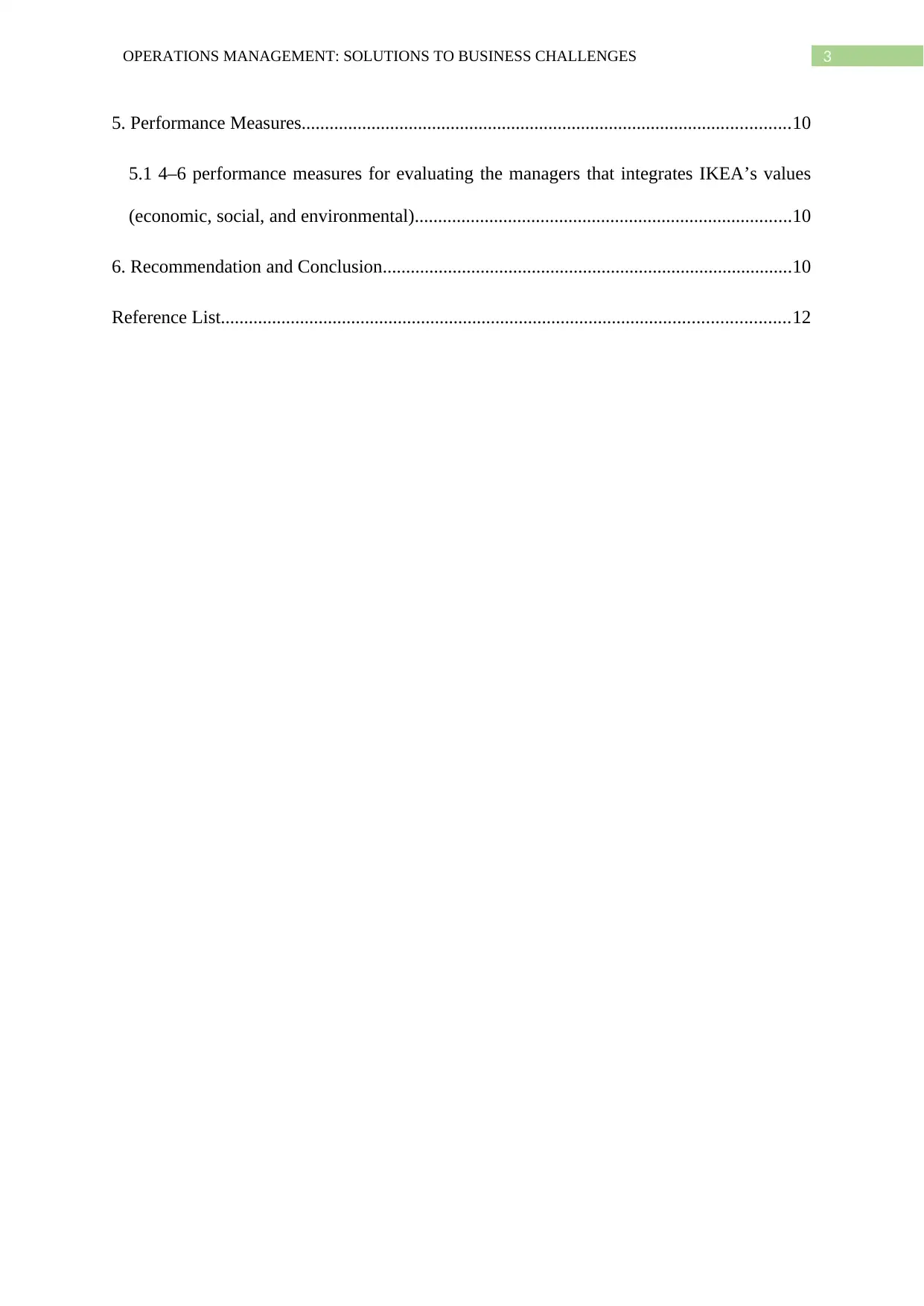
3OPERATIONS MANAGEMENT: SOLUTIONS TO BUSINESS CHALLENGES
5. Performance Measures.........................................................................................................10
5.1 4–6 performance measures for evaluating the managers that integrates IKEA’s values
(economic, social, and environmental).................................................................................10
6. Recommendation and Conclusion........................................................................................10
Reference List..........................................................................................................................12
5. Performance Measures.........................................................................................................10
5.1 4–6 performance measures for evaluating the managers that integrates IKEA’s values
(economic, social, and environmental).................................................................................10
6. Recommendation and Conclusion........................................................................................10
Reference List..........................................................................................................................12
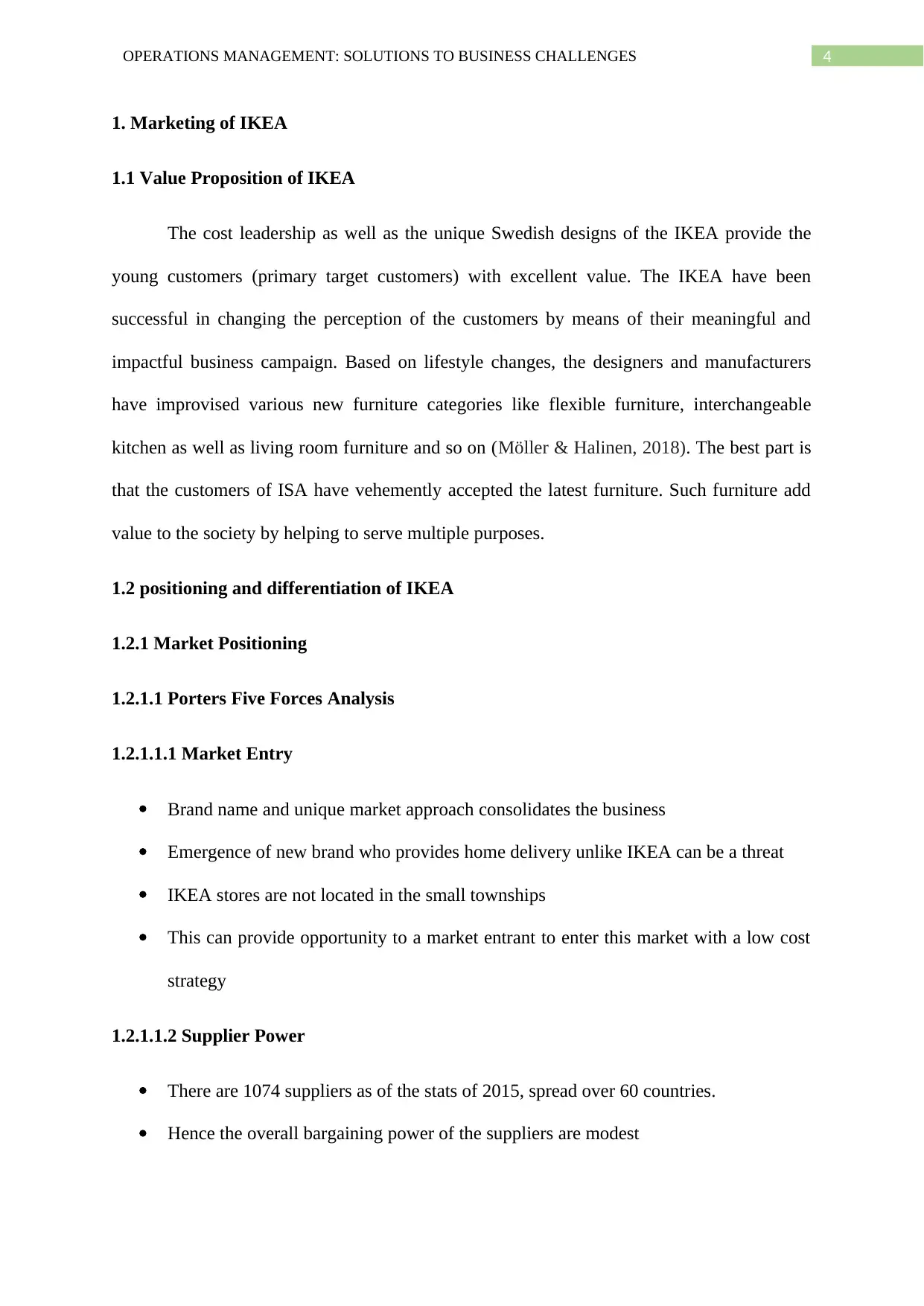
4OPERATIONS MANAGEMENT: SOLUTIONS TO BUSINESS CHALLENGES
1. Marketing of IKEA
1.1 Value Proposition of IKEA
The cost leadership as well as the unique Swedish designs of the IKEA provide the
young customers (primary target customers) with excellent value. The IKEA have been
successful in changing the perception of the customers by means of their meaningful and
impactful business campaign. Based on lifestyle changes, the designers and manufacturers
have improvised various new furniture categories like flexible furniture, interchangeable
kitchen as well as living room furniture and so on (Möller & Halinen, 2018). The best part is
that the customers of ISA have vehemently accepted the latest furniture. Such furniture add
value to the society by helping to serve multiple purposes.
1.2 positioning and differentiation of IKEA
1.2.1 Market Positioning
1.2.1.1 Porters Five Forces Analysis
1.2.1.1.1 Market Entry
Brand name and unique market approach consolidates the business
Emergence of new brand who provides home delivery unlike IKEA can be a threat
IKEA stores are not located in the small townships
This can provide opportunity to a market entrant to enter this market with a low cost
strategy
1.2.1.1.2 Supplier Power
There are 1074 suppliers as of the stats of 2015, spread over 60 countries.
Hence the overall bargaining power of the suppliers are modest
1. Marketing of IKEA
1.1 Value Proposition of IKEA
The cost leadership as well as the unique Swedish designs of the IKEA provide the
young customers (primary target customers) with excellent value. The IKEA have been
successful in changing the perception of the customers by means of their meaningful and
impactful business campaign. Based on lifestyle changes, the designers and manufacturers
have improvised various new furniture categories like flexible furniture, interchangeable
kitchen as well as living room furniture and so on (Möller & Halinen, 2018). The best part is
that the customers of ISA have vehemently accepted the latest furniture. Such furniture add
value to the society by helping to serve multiple purposes.
1.2 positioning and differentiation of IKEA
1.2.1 Market Positioning
1.2.1.1 Porters Five Forces Analysis
1.2.1.1.1 Market Entry
Brand name and unique market approach consolidates the business
Emergence of new brand who provides home delivery unlike IKEA can be a threat
IKEA stores are not located in the small townships
This can provide opportunity to a market entrant to enter this market with a low cost
strategy
1.2.1.1.2 Supplier Power
There are 1074 suppliers as of the stats of 2015, spread over 60 countries.
Hence the overall bargaining power of the suppliers are modest
Secure Best Marks with AI Grader
Need help grading? Try our AI Grader for instant feedback on your assignments.
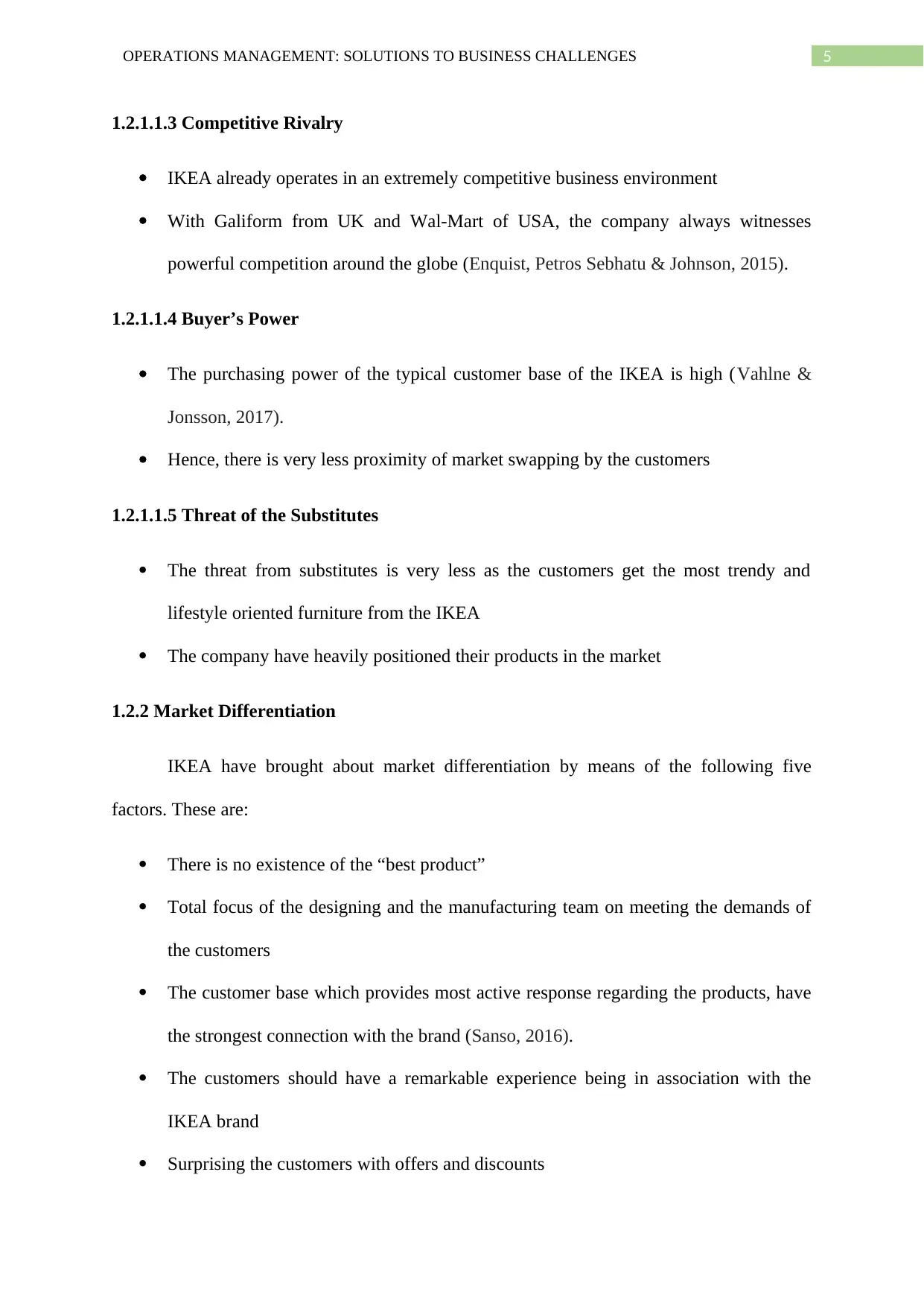
5OPERATIONS MANAGEMENT: SOLUTIONS TO BUSINESS CHALLENGES
1.2.1.1.3 Competitive Rivalry
IKEA already operates in an extremely competitive business environment
With Galiform from UK and Wal-Mart of USA, the company always witnesses
powerful competition around the globe (Enquist, Petros Sebhatu & Johnson, 2015).
1.2.1.1.4 Buyer’s Power
The purchasing power of the typical customer base of the IKEA is high (Vahlne &
Jonsson, 2017).
Hence, there is very less proximity of market swapping by the customers
1.2.1.1.5 Threat of the Substitutes
The threat from substitutes is very less as the customers get the most trendy and
lifestyle oriented furniture from the IKEA
The company have heavily positioned their products in the market
1.2.2 Market Differentiation
IKEA have brought about market differentiation by means of the following five
factors. These are:
There is no existence of the “best product”
Total focus of the designing and the manufacturing team on meeting the demands of
the customers
The customer base which provides most active response regarding the products, have
the strongest connection with the brand (Sanso, 2016).
The customers should have a remarkable experience being in association with the
IKEA brand
Surprising the customers with offers and discounts
1.2.1.1.3 Competitive Rivalry
IKEA already operates in an extremely competitive business environment
With Galiform from UK and Wal-Mart of USA, the company always witnesses
powerful competition around the globe (Enquist, Petros Sebhatu & Johnson, 2015).
1.2.1.1.4 Buyer’s Power
The purchasing power of the typical customer base of the IKEA is high (Vahlne &
Jonsson, 2017).
Hence, there is very less proximity of market swapping by the customers
1.2.1.1.5 Threat of the Substitutes
The threat from substitutes is very less as the customers get the most trendy and
lifestyle oriented furniture from the IKEA
The company have heavily positioned their products in the market
1.2.2 Market Differentiation
IKEA have brought about market differentiation by means of the following five
factors. These are:
There is no existence of the “best product”
Total focus of the designing and the manufacturing team on meeting the demands of
the customers
The customer base which provides most active response regarding the products, have
the strongest connection with the brand (Sanso, 2016).
The customers should have a remarkable experience being in association with the
IKEA brand
Surprising the customers with offers and discounts
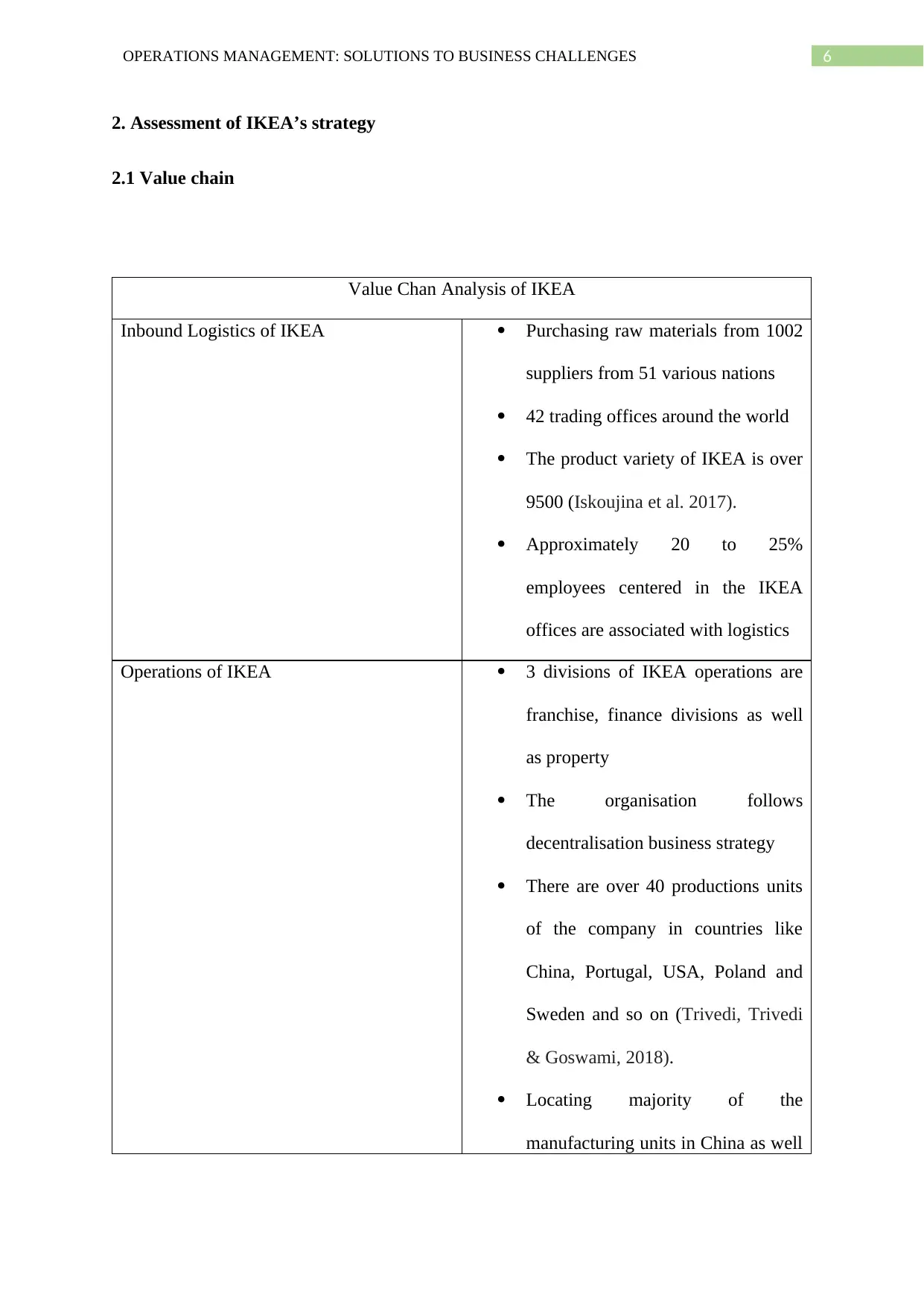
6OPERATIONS MANAGEMENT: SOLUTIONS TO BUSINESS CHALLENGES
2. Assessment of IKEA’s strategy
2.1 Value chain
Value Chan Analysis of IKEA
Inbound Logistics of IKEA Purchasing raw materials from 1002
suppliers from 51 various nations
42 trading offices around the world
The product variety of IKEA is over
9500 (Iskoujina et al. 2017).
Approximately 20 to 25%
employees centered in the IKEA
offices are associated with logistics
Operations of IKEA 3 divisions of IKEA operations are
franchise, finance divisions as well
as property
The organisation follows
decentralisation business strategy
There are over 40 productions units
of the company in countries like
China, Portugal, USA, Poland and
Sweden and so on (Trivedi, Trivedi
& Goswami, 2018).
Locating majority of the
manufacturing units in China as well
2. Assessment of IKEA’s strategy
2.1 Value chain
Value Chan Analysis of IKEA
Inbound Logistics of IKEA Purchasing raw materials from 1002
suppliers from 51 various nations
42 trading offices around the world
The product variety of IKEA is over
9500 (Iskoujina et al. 2017).
Approximately 20 to 25%
employees centered in the IKEA
offices are associated with logistics
Operations of IKEA 3 divisions of IKEA operations are
franchise, finance divisions as well
as property
The organisation follows
decentralisation business strategy
There are over 40 productions units
of the company in countries like
China, Portugal, USA, Poland and
Sweden and so on (Trivedi, Trivedi
& Goswami, 2018).
Locating majority of the
manufacturing units in China as well
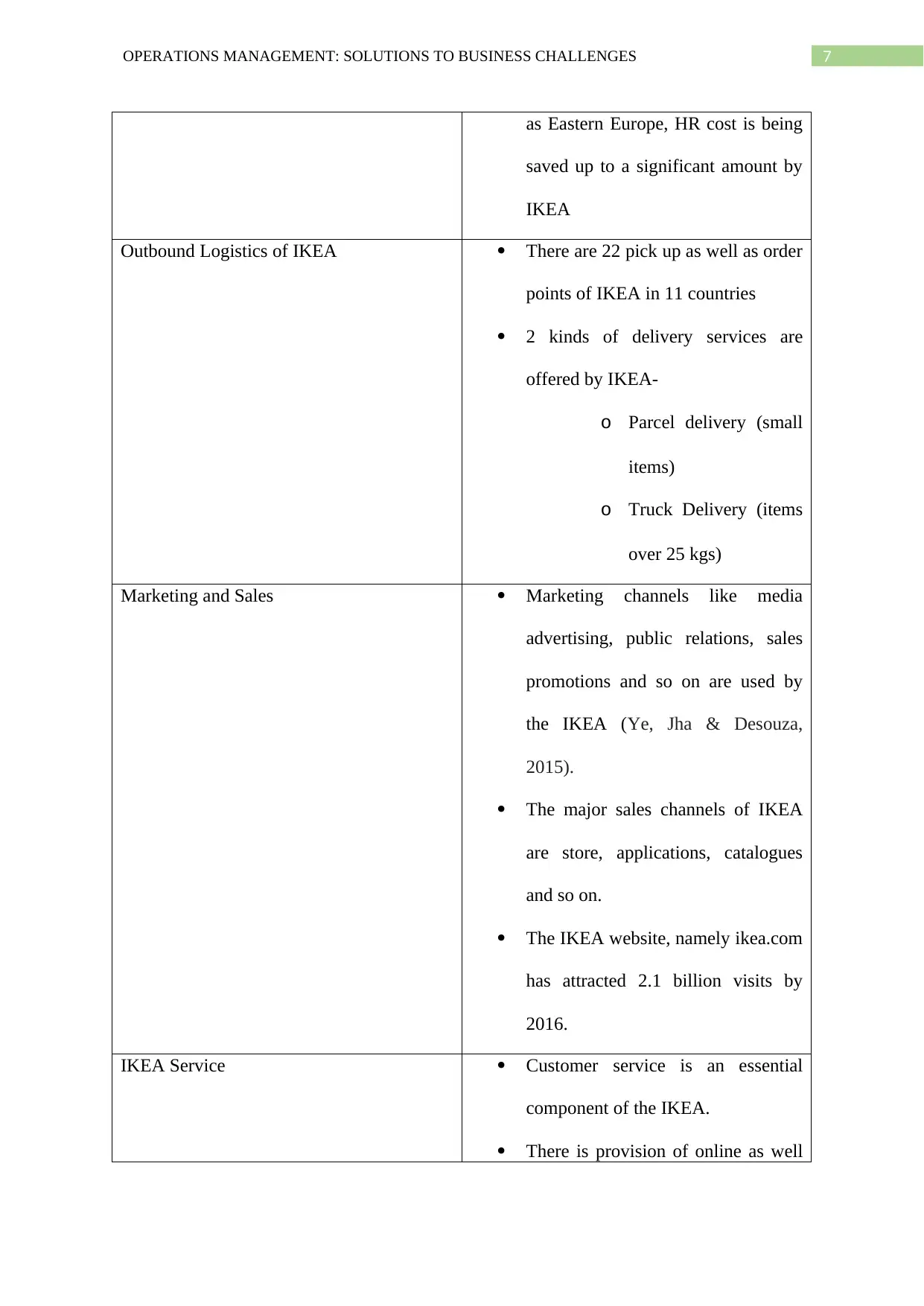
7OPERATIONS MANAGEMENT: SOLUTIONS TO BUSINESS CHALLENGES
as Eastern Europe, HR cost is being
saved up to a significant amount by
IKEA
Outbound Logistics of IKEA There are 22 pick up as well as order
points of IKEA in 11 countries
2 kinds of delivery services are
offered by IKEA-
o Parcel delivery (small
items)
o Truck Delivery (items
over 25 kgs)
Marketing and Sales Marketing channels like media
advertising, public relations, sales
promotions and so on are used by
the IKEA (Ye, Jha & Desouza,
2015).
The major sales channels of IKEA
are store, applications, catalogues
and so on.
The IKEA website, namely ikea.com
has attracted 2.1 billion visits by
2016.
IKEA Service Customer service is an essential
component of the IKEA.
There is provision of online as well
as Eastern Europe, HR cost is being
saved up to a significant amount by
IKEA
Outbound Logistics of IKEA There are 22 pick up as well as order
points of IKEA in 11 countries
2 kinds of delivery services are
offered by IKEA-
o Parcel delivery (small
items)
o Truck Delivery (items
over 25 kgs)
Marketing and Sales Marketing channels like media
advertising, public relations, sales
promotions and so on are used by
the IKEA (Ye, Jha & Desouza,
2015).
The major sales channels of IKEA
are store, applications, catalogues
and so on.
The IKEA website, namely ikea.com
has attracted 2.1 billion visits by
2016.
IKEA Service Customer service is an essential
component of the IKEA.
There is provision of online as well
Paraphrase This Document
Need a fresh take? Get an instant paraphrase of this document with our AI Paraphraser
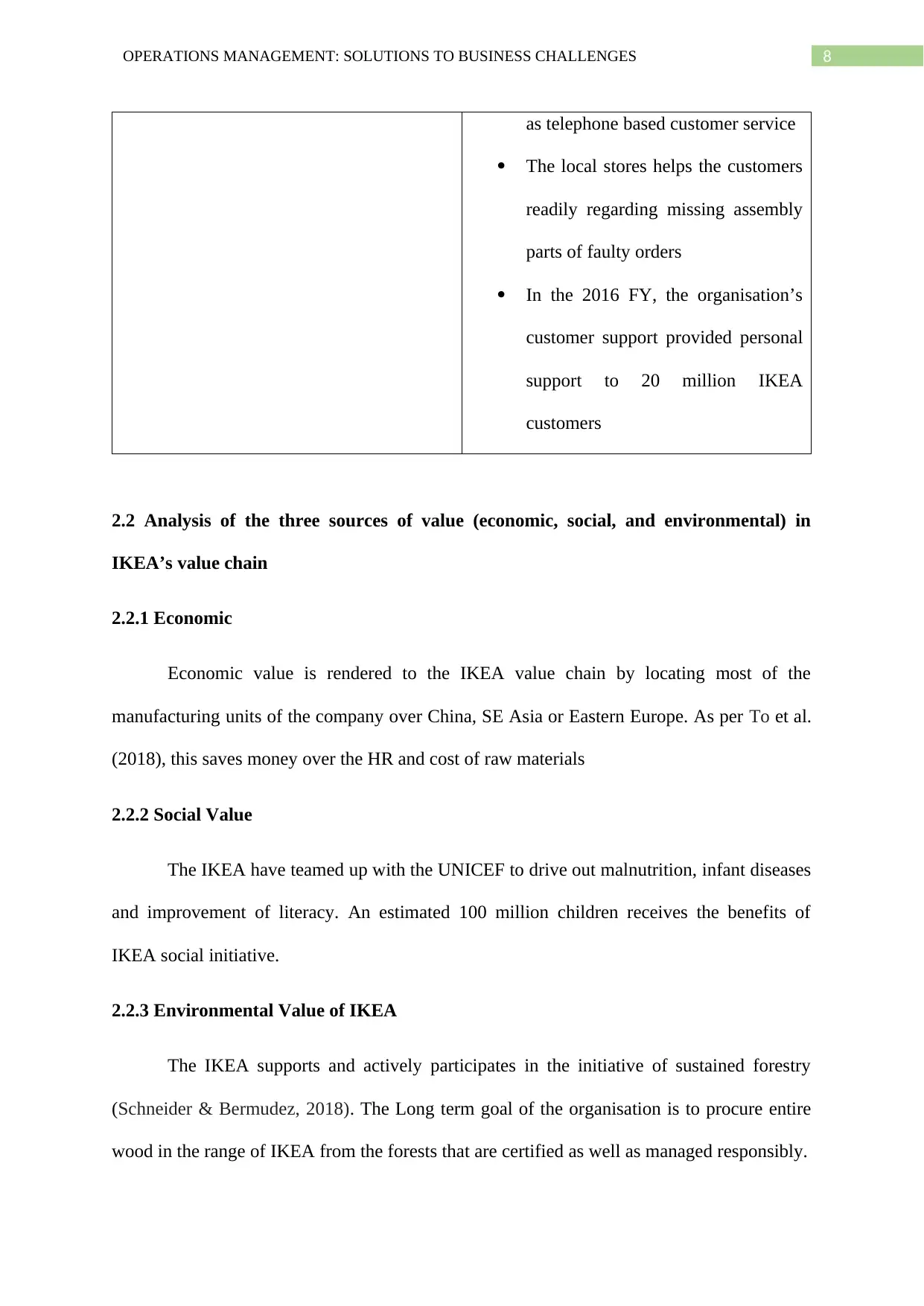
8OPERATIONS MANAGEMENT: SOLUTIONS TO BUSINESS CHALLENGES
as telephone based customer service
The local stores helps the customers
readily regarding missing assembly
parts of faulty orders
In the 2016 FY, the organisation’s
customer support provided personal
support to 20 million IKEA
customers
2.2 Analysis of the three sources of value (economic, social, and environmental) in
IKEA’s value chain
2.2.1 Economic
Economic value is rendered to the IKEA value chain by locating most of the
manufacturing units of the company over China, SE Asia or Eastern Europe. As per To et al.
(2018), this saves money over the HR and cost of raw materials
2.2.2 Social Value
The IKEA have teamed up with the UNICEF to drive out malnutrition, infant diseases
and improvement of literacy. An estimated 100 million children receives the benefits of
IKEA social initiative.
2.2.3 Environmental Value of IKEA
The IKEA supports and actively participates in the initiative of sustained forestry
(Schneider & Bermudez, 2018). The Long term goal of the organisation is to procure entire
wood in the range of IKEA from the forests that are certified as well as managed responsibly.
as telephone based customer service
The local stores helps the customers
readily regarding missing assembly
parts of faulty orders
In the 2016 FY, the organisation’s
customer support provided personal
support to 20 million IKEA
customers
2.2 Analysis of the three sources of value (economic, social, and environmental) in
IKEA’s value chain
2.2.1 Economic
Economic value is rendered to the IKEA value chain by locating most of the
manufacturing units of the company over China, SE Asia or Eastern Europe. As per To et al.
(2018), this saves money over the HR and cost of raw materials
2.2.2 Social Value
The IKEA have teamed up with the UNICEF to drive out malnutrition, infant diseases
and improvement of literacy. An estimated 100 million children receives the benefits of
IKEA social initiative.
2.2.3 Environmental Value of IKEA
The IKEA supports and actively participates in the initiative of sustained forestry
(Schneider & Bermudez, 2018). The Long term goal of the organisation is to procure entire
wood in the range of IKEA from the forests that are certified as well as managed responsibly.
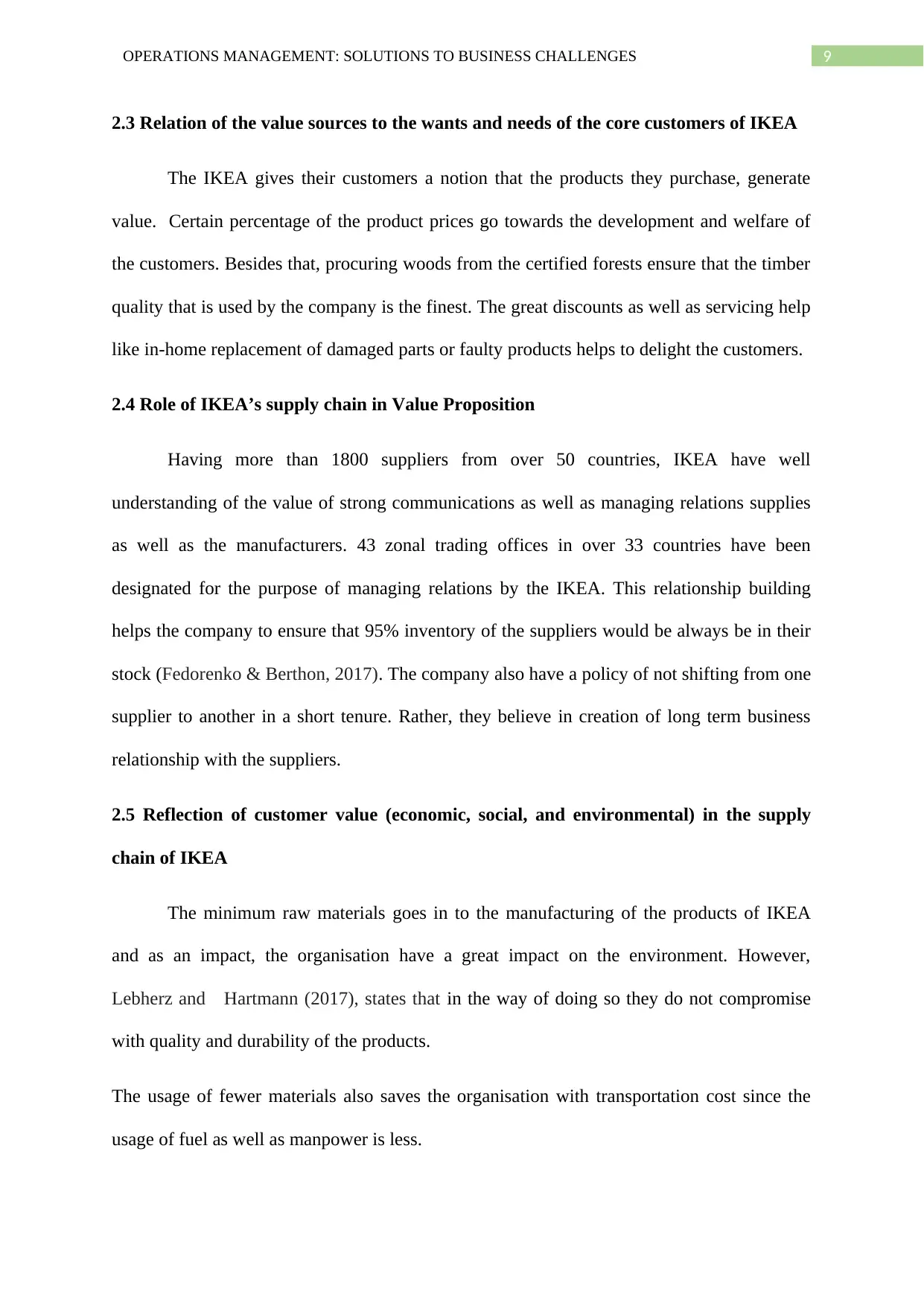
9OPERATIONS MANAGEMENT: SOLUTIONS TO BUSINESS CHALLENGES
2.3 Relation of the value sources to the wants and needs of the core customers of IKEA
The IKEA gives their customers a notion that the products they purchase, generate
value. Certain percentage of the product prices go towards the development and welfare of
the customers. Besides that, procuring woods from the certified forests ensure that the timber
quality that is used by the company is the finest. The great discounts as well as servicing help
like in-home replacement of damaged parts or faulty products helps to delight the customers.
2.4 Role of IKEA’s supply chain in Value Proposition
Having more than 1800 suppliers from over 50 countries, IKEA have well
understanding of the value of strong communications as well as managing relations supplies
as well as the manufacturers. 43 zonal trading offices in over 33 countries have been
designated for the purpose of managing relations by the IKEA. This relationship building
helps the company to ensure that 95% inventory of the suppliers would be always be in their
stock (Fedorenko & Berthon, 2017). The company also have a policy of not shifting from one
supplier to another in a short tenure. Rather, they believe in creation of long term business
relationship with the suppliers.
2.5 Reflection of customer value (economic, social, and environmental) in the supply
chain of IKEA
The minimum raw materials goes in to the manufacturing of the products of IKEA
and as an impact, the organisation have a great impact on the environment. However,
Lebherz and Hartmann (2017), states that in the way of doing so they do not compromise
with quality and durability of the products.
The usage of fewer materials also saves the organisation with transportation cost since the
usage of fuel as well as manpower is less.
2.3 Relation of the value sources to the wants and needs of the core customers of IKEA
The IKEA gives their customers a notion that the products they purchase, generate
value. Certain percentage of the product prices go towards the development and welfare of
the customers. Besides that, procuring woods from the certified forests ensure that the timber
quality that is used by the company is the finest. The great discounts as well as servicing help
like in-home replacement of damaged parts or faulty products helps to delight the customers.
2.4 Role of IKEA’s supply chain in Value Proposition
Having more than 1800 suppliers from over 50 countries, IKEA have well
understanding of the value of strong communications as well as managing relations supplies
as well as the manufacturers. 43 zonal trading offices in over 33 countries have been
designated for the purpose of managing relations by the IKEA. This relationship building
helps the company to ensure that 95% inventory of the suppliers would be always be in their
stock (Fedorenko & Berthon, 2017). The company also have a policy of not shifting from one
supplier to another in a short tenure. Rather, they believe in creation of long term business
relationship with the suppliers.
2.5 Reflection of customer value (economic, social, and environmental) in the supply
chain of IKEA
The minimum raw materials goes in to the manufacturing of the products of IKEA
and as an impact, the organisation have a great impact on the environment. However,
Lebherz and Hartmann (2017), states that in the way of doing so they do not compromise
with quality and durability of the products.
The usage of fewer materials also saves the organisation with transportation cost since the
usage of fuel as well as manpower is less.
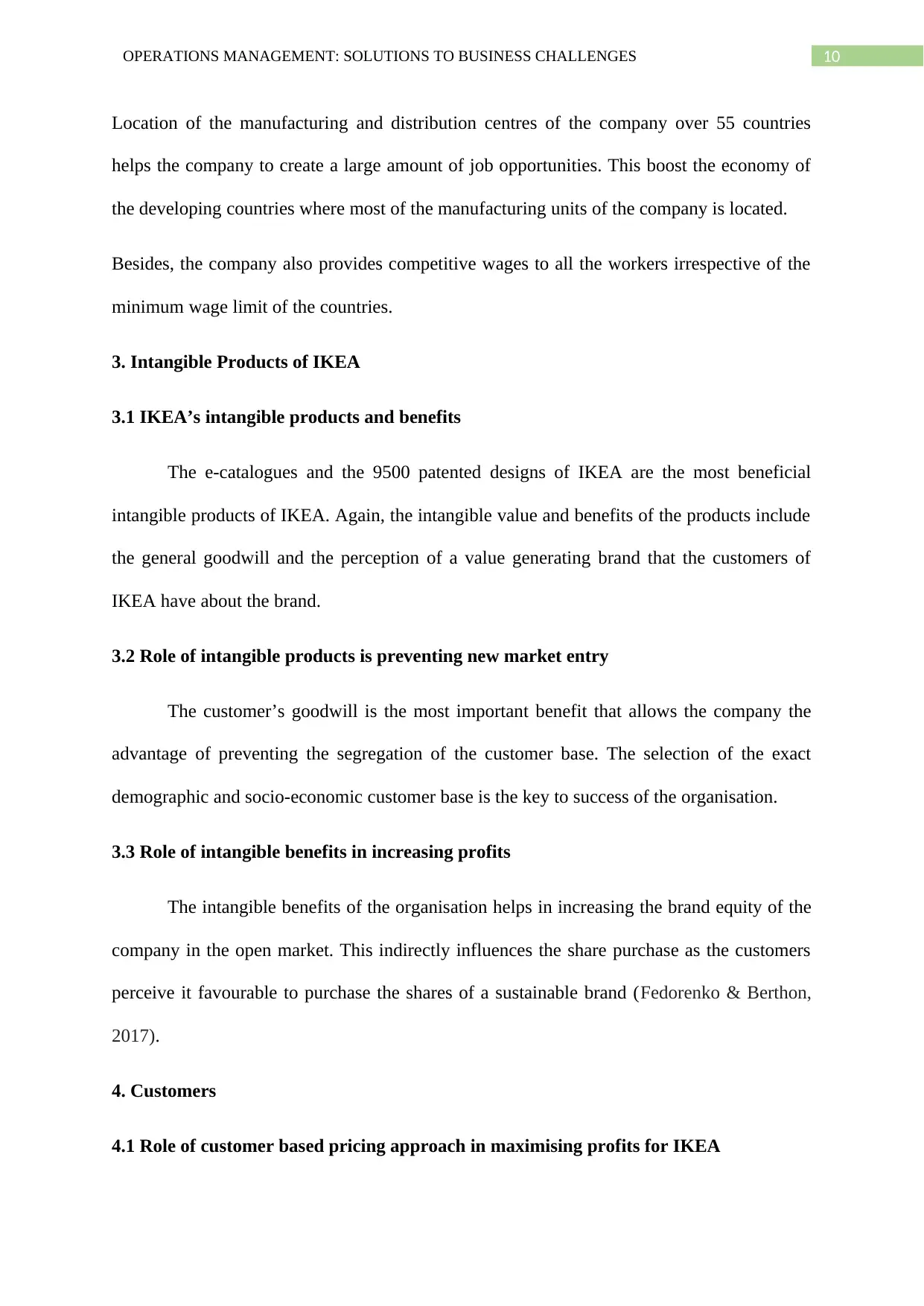
10OPERATIONS MANAGEMENT: SOLUTIONS TO BUSINESS CHALLENGES
Location of the manufacturing and distribution centres of the company over 55 countries
helps the company to create a large amount of job opportunities. This boost the economy of
the developing countries where most of the manufacturing units of the company is located.
Besides, the company also provides competitive wages to all the workers irrespective of the
minimum wage limit of the countries.
3. Intangible Products of IKEA
3.1 IKEA’s intangible products and benefits
The e-catalogues and the 9500 patented designs of IKEA are the most beneficial
intangible products of IKEA. Again, the intangible value and benefits of the products include
the general goodwill and the perception of a value generating brand that the customers of
IKEA have about the brand.
3.2 Role of intangible products is preventing new market entry
The customer’s goodwill is the most important benefit that allows the company the
advantage of preventing the segregation of the customer base. The selection of the exact
demographic and socio-economic customer base is the key to success of the organisation.
3.3 Role of intangible benefits in increasing profits
The intangible benefits of the organisation helps in increasing the brand equity of the
company in the open market. This indirectly influences the share purchase as the customers
perceive it favourable to purchase the shares of a sustainable brand (Fedorenko & Berthon,
2017).
4. Customers
4.1 Role of customer based pricing approach in maximising profits for IKEA
Location of the manufacturing and distribution centres of the company over 55 countries
helps the company to create a large amount of job opportunities. This boost the economy of
the developing countries where most of the manufacturing units of the company is located.
Besides, the company also provides competitive wages to all the workers irrespective of the
minimum wage limit of the countries.
3. Intangible Products of IKEA
3.1 IKEA’s intangible products and benefits
The e-catalogues and the 9500 patented designs of IKEA are the most beneficial
intangible products of IKEA. Again, the intangible value and benefits of the products include
the general goodwill and the perception of a value generating brand that the customers of
IKEA have about the brand.
3.2 Role of intangible products is preventing new market entry
The customer’s goodwill is the most important benefit that allows the company the
advantage of preventing the segregation of the customer base. The selection of the exact
demographic and socio-economic customer base is the key to success of the organisation.
3.3 Role of intangible benefits in increasing profits
The intangible benefits of the organisation helps in increasing the brand equity of the
company in the open market. This indirectly influences the share purchase as the customers
perceive it favourable to purchase the shares of a sustainable brand (Fedorenko & Berthon,
2017).
4. Customers
4.1 Role of customer based pricing approach in maximising profits for IKEA
Secure Best Marks with AI Grader
Need help grading? Try our AI Grader for instant feedback on your assignments.
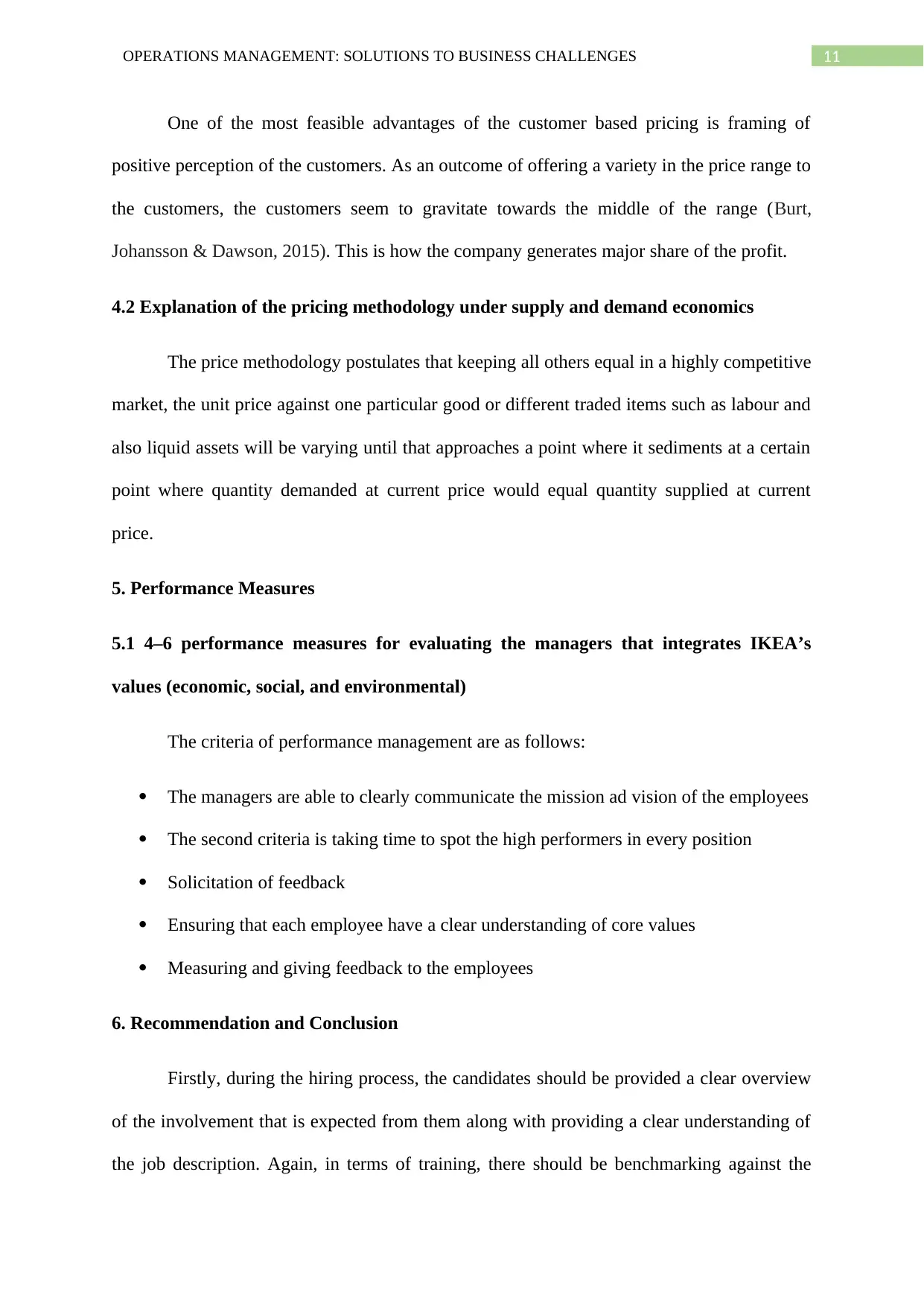
11OPERATIONS MANAGEMENT: SOLUTIONS TO BUSINESS CHALLENGES
One of the most feasible advantages of the customer based pricing is framing of
positive perception of the customers. As an outcome of offering a variety in the price range to
the customers, the customers seem to gravitate towards the middle of the range (Burt,
Johansson & Dawson, 2015). This is how the company generates major share of the profit.
4.2 Explanation of the pricing methodology under supply and demand economics
The price methodology postulates that keeping all others equal in a highly competitive
market, the unit price against one particular good or different traded items such as labour and
also liquid assets will be varying until that approaches a point where it sediments at a certain
point where quantity demanded at current price would equal quantity supplied at current
price.
5. Performance Measures
5.1 4–6 performance measures for evaluating the managers that integrates IKEA’s
values (economic, social, and environmental)
The criteria of performance management are as follows:
The managers are able to clearly communicate the mission ad vision of the employees
The second criteria is taking time to spot the high performers in every position
Solicitation of feedback
Ensuring that each employee have a clear understanding of core values
Measuring and giving feedback to the employees
6. Recommendation and Conclusion
Firstly, during the hiring process, the candidates should be provided a clear overview
of the involvement that is expected from them along with providing a clear understanding of
the job description. Again, in terms of training, there should be benchmarking against the
One of the most feasible advantages of the customer based pricing is framing of
positive perception of the customers. As an outcome of offering a variety in the price range to
the customers, the customers seem to gravitate towards the middle of the range (Burt,
Johansson & Dawson, 2015). This is how the company generates major share of the profit.
4.2 Explanation of the pricing methodology under supply and demand economics
The price methodology postulates that keeping all others equal in a highly competitive
market, the unit price against one particular good or different traded items such as labour and
also liquid assets will be varying until that approaches a point where it sediments at a certain
point where quantity demanded at current price would equal quantity supplied at current
price.
5. Performance Measures
5.1 4–6 performance measures for evaluating the managers that integrates IKEA’s
values (economic, social, and environmental)
The criteria of performance management are as follows:
The managers are able to clearly communicate the mission ad vision of the employees
The second criteria is taking time to spot the high performers in every position
Solicitation of feedback
Ensuring that each employee have a clear understanding of core values
Measuring and giving feedback to the employees
6. Recommendation and Conclusion
Firstly, during the hiring process, the candidates should be provided a clear overview
of the involvement that is expected from them along with providing a clear understanding of
the job description. Again, in terms of training, there should be benchmarking against the
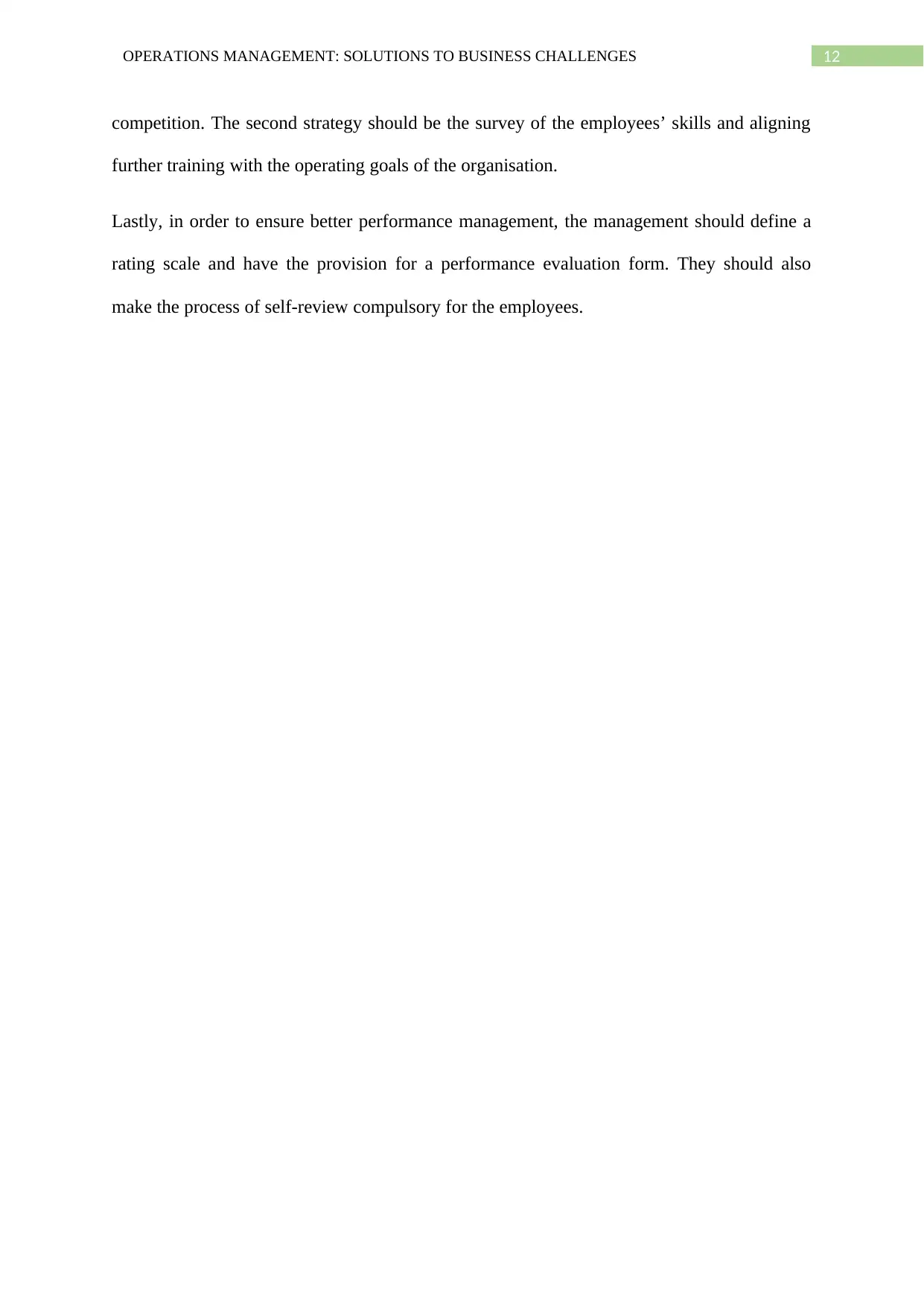
12OPERATIONS MANAGEMENT: SOLUTIONS TO BUSINESS CHALLENGES
competition. The second strategy should be the survey of the employees’ skills and aligning
further training with the operating goals of the organisation.
Lastly, in order to ensure better performance management, the management should define a
rating scale and have the provision for a performance evaluation form. They should also
make the process of self-review compulsory for the employees.
competition. The second strategy should be the survey of the employees’ skills and aligning
further training with the operating goals of the organisation.
Lastly, in order to ensure better performance management, the management should define a
rating scale and have the provision for a performance evaluation form. They should also
make the process of self-review compulsory for the employees.
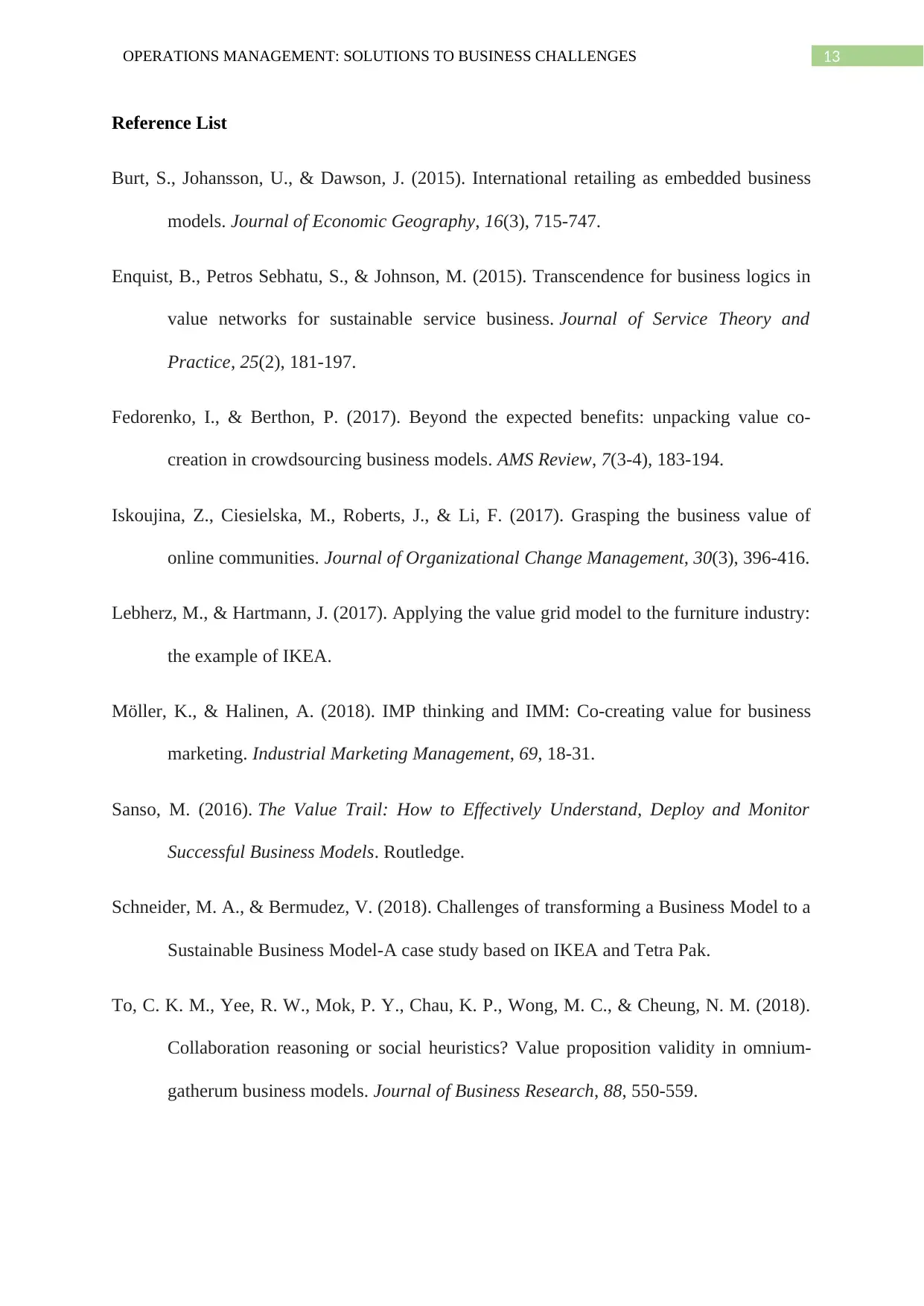
13OPERATIONS MANAGEMENT: SOLUTIONS TO BUSINESS CHALLENGES
Reference List
Burt, S., Johansson, U., & Dawson, J. (2015). International retailing as embedded business
models. Journal of Economic Geography, 16(3), 715-747.
Enquist, B., Petros Sebhatu, S., & Johnson, M. (2015). Transcendence for business logics in
value networks for sustainable service business. Journal of Service Theory and
Practice, 25(2), 181-197.
Fedorenko, I., & Berthon, P. (2017). Beyond the expected benefits: unpacking value co-
creation in crowdsourcing business models. AMS Review, 7(3-4), 183-194.
Iskoujina, Z., Ciesielska, M., Roberts, J., & Li, F. (2017). Grasping the business value of
online communities. Journal of Organizational Change Management, 30(3), 396-416.
Lebherz, M., & Hartmann, J. (2017). Applying the value grid model to the furniture industry:
the example of IKEA.
Möller, K., & Halinen, A. (2018). IMP thinking and IMM: Co-creating value for business
marketing. Industrial Marketing Management, 69, 18-31.
Sanso, M. (2016). The Value Trail: How to Effectively Understand, Deploy and Monitor
Successful Business Models. Routledge.
Schneider, M. A., & Bermudez, V. (2018). Challenges of transforming a Business Model to a
Sustainable Business Model-A case study based on IKEA and Tetra Pak.
To, C. K. M., Yee, R. W., Mok, P. Y., Chau, K. P., Wong, M. C., & Cheung, N. M. (2018).
Collaboration reasoning or social heuristics? Value proposition validity in omnium-
gatherum business models. Journal of Business Research, 88, 550-559.
Reference List
Burt, S., Johansson, U., & Dawson, J. (2015). International retailing as embedded business
models. Journal of Economic Geography, 16(3), 715-747.
Enquist, B., Petros Sebhatu, S., & Johnson, M. (2015). Transcendence for business logics in
value networks for sustainable service business. Journal of Service Theory and
Practice, 25(2), 181-197.
Fedorenko, I., & Berthon, P. (2017). Beyond the expected benefits: unpacking value co-
creation in crowdsourcing business models. AMS Review, 7(3-4), 183-194.
Iskoujina, Z., Ciesielska, M., Roberts, J., & Li, F. (2017). Grasping the business value of
online communities. Journal of Organizational Change Management, 30(3), 396-416.
Lebherz, M., & Hartmann, J. (2017). Applying the value grid model to the furniture industry:
the example of IKEA.
Möller, K., & Halinen, A. (2018). IMP thinking and IMM: Co-creating value for business
marketing. Industrial Marketing Management, 69, 18-31.
Sanso, M. (2016). The Value Trail: How to Effectively Understand, Deploy and Monitor
Successful Business Models. Routledge.
Schneider, M. A., & Bermudez, V. (2018). Challenges of transforming a Business Model to a
Sustainable Business Model-A case study based on IKEA and Tetra Pak.
To, C. K. M., Yee, R. W., Mok, P. Y., Chau, K. P., Wong, M. C., & Cheung, N. M. (2018).
Collaboration reasoning or social heuristics? Value proposition validity in omnium-
gatherum business models. Journal of Business Research, 88, 550-559.
Paraphrase This Document
Need a fresh take? Get an instant paraphrase of this document with our AI Paraphraser
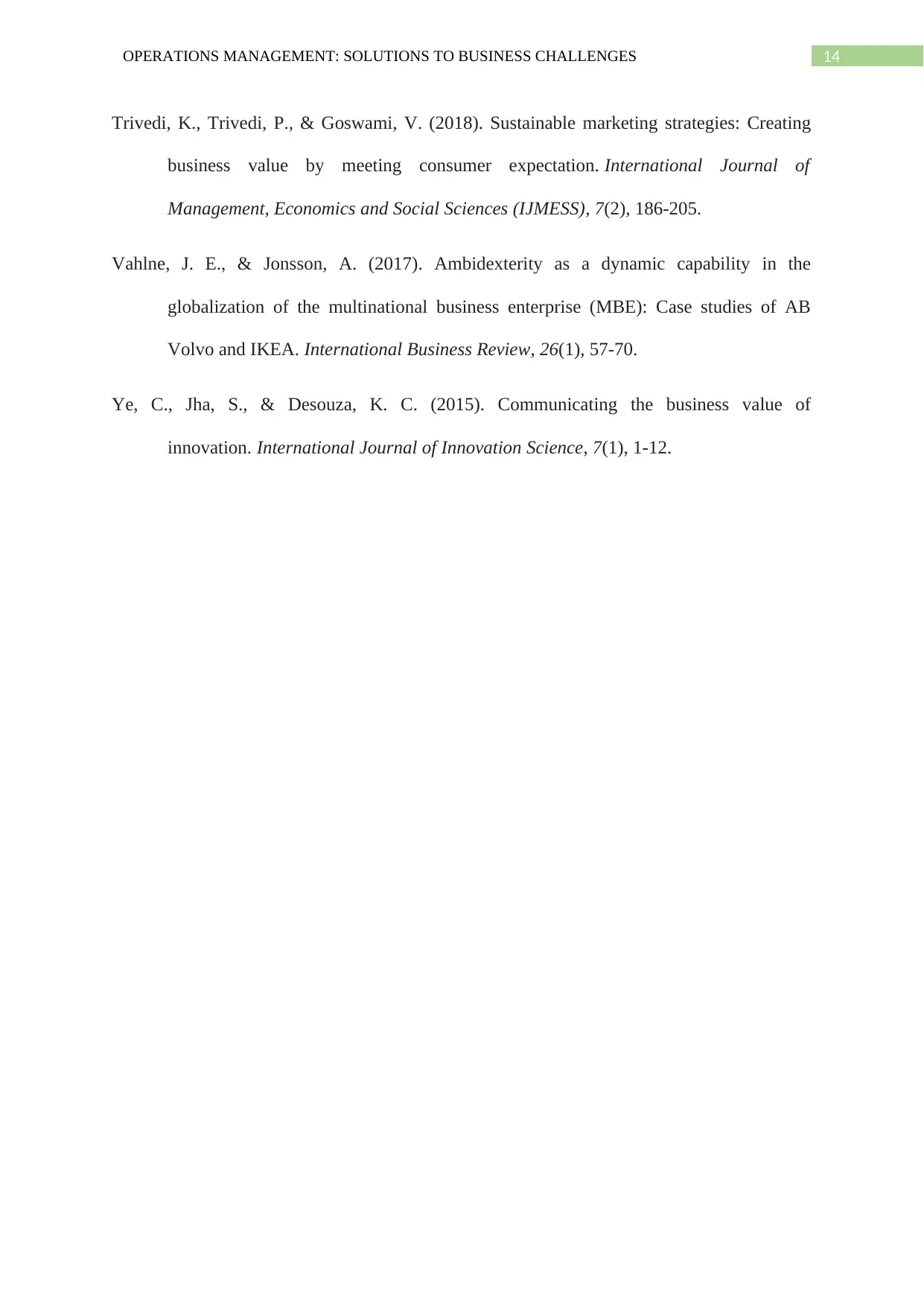
14OPERATIONS MANAGEMENT: SOLUTIONS TO BUSINESS CHALLENGES
Trivedi, K., Trivedi, P., & Goswami, V. (2018). Sustainable marketing strategies: Creating
business value by meeting consumer expectation. International Journal of
Management, Economics and Social Sciences (IJMESS), 7(2), 186-205.
Vahlne, J. E., & Jonsson, A. (2017). Ambidexterity as a dynamic capability in the
globalization of the multinational business enterprise (MBE): Case studies of AB
Volvo and IKEA. International Business Review, 26(1), 57-70.
Ye, C., Jha, S., & Desouza, K. C. (2015). Communicating the business value of
innovation. International Journal of Innovation Science, 7(1), 1-12.
Trivedi, K., Trivedi, P., & Goswami, V. (2018). Sustainable marketing strategies: Creating
business value by meeting consumer expectation. International Journal of
Management, Economics and Social Sciences (IJMESS), 7(2), 186-205.
Vahlne, J. E., & Jonsson, A. (2017). Ambidexterity as a dynamic capability in the
globalization of the multinational business enterprise (MBE): Case studies of AB
Volvo and IKEA. International Business Review, 26(1), 57-70.
Ye, C., Jha, S., & Desouza, K. C. (2015). Communicating the business value of
innovation. International Journal of Innovation Science, 7(1), 1-12.
1 out of 14
Related Documents
Your All-in-One AI-Powered Toolkit for Academic Success.
+13062052269
info@desklib.com
Available 24*7 on WhatsApp / Email
![[object Object]](/_next/static/media/star-bottom.7253800d.svg)
Unlock your academic potential
© 2024 | Zucol Services PVT LTD | All rights reserved.





